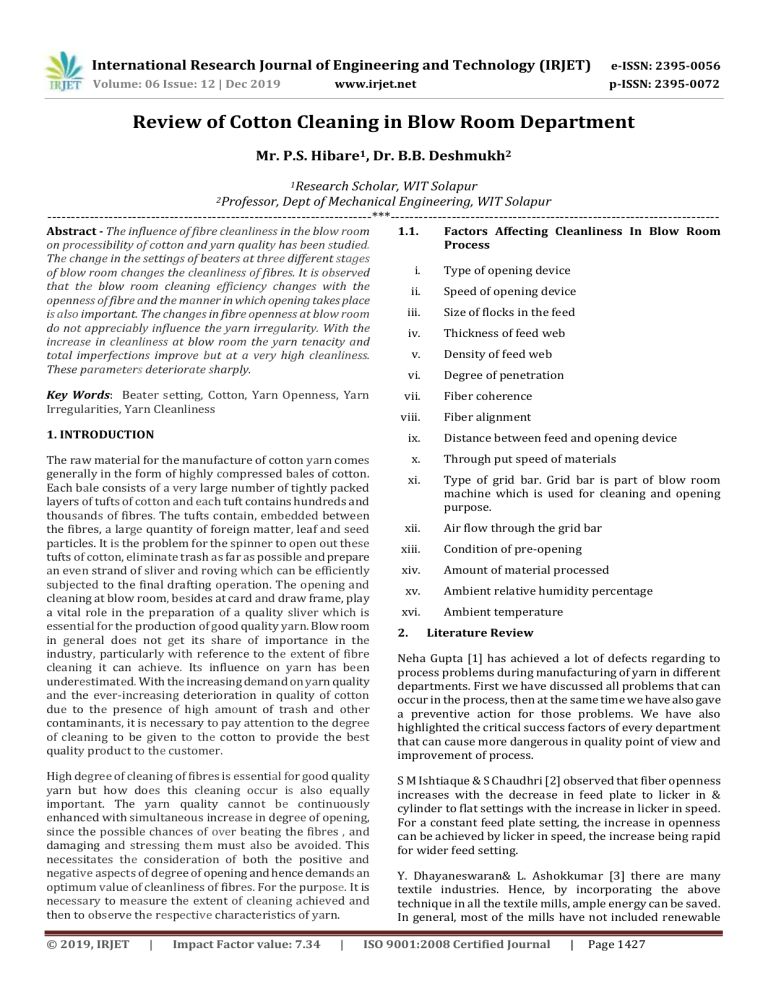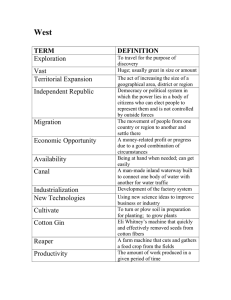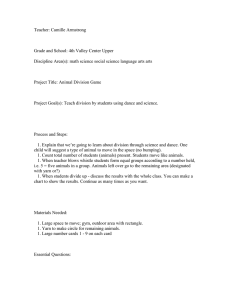IRJET- Review of Cotton Cleaning in Blow Room Department
advertisement

International Research Journal of Engineering and Technology (IRJET) e-ISSN: 2395-0056 Volume: 06 Issue: 12 | Dec 2019 p-ISSN: 2395-0072 www.irjet.net Review of Cotton Cleaning in Blow Room Department Mr. P.S. Hibare1, Dr. B.B. Deshmukh2 Scholar, WIT Solapur Dept of Mechanical Engineering, WIT Solapur ---------------------------------------------------------------------***---------------------------------------------------------------------2Professor, 1Research Abstract - The influence of fibre cleanliness in the blow room on processibility of cotton and yarn quality has been studied. The change in the settings of beaters at three different stages of blow room changes the cleanliness of fibres. It is observed that the blow room cleaning efficiency changes with the openness of fibre and the manner in which opening takes place is also important. The changes in fibre openness at blow room do not appreciably influence the yarn irregularity. With the increase in cleanliness at blow room the yarn tenacity and total imperfections improve but at a very high cleanliness. These parameters deteriorate sharply. 1.1. Key Words: Beater setting, Cotton, Yarn Openness, Yarn Irregularities, Yarn Cleanliness Factors Affecting Cleanliness In Blow Room Process i. Type of opening device ii. Speed of opening device iii. Size of flocks in the feed iv. Thickness of feed web v. Density of feed web vi. Degree of penetration vii. Fiber coherence viii. Fiber alignment 1. INTRODUCTION ix. Distance between feed and opening device The raw material for the manufacture of cotton yarn comes generally in the form of highly compressed bales of cotton. Each bale consists of a very large number of tightly packed layers of tufts of cotton and each tuft contains hundreds and thousands of fibres. The tufts contain, embedded between the fibres, a large quantity of foreign matter, leaf and seed particles. It is the problem for the spinner to open out these tufts of cotton, eliminate trash as far as possible and prepare an even strand of sliver and roving which can be efficiently subjected to the final drafting operation. The opening and cleaning at blow room, besides at card and draw frame, play a vital role in the preparation of a quality sliver which is essential for the production of good quality yarn. Blow room in general does not get its share of importance in the industry, particularly with reference to the extent of fibre cleaning it can achieve. Its influence on yarn has been underestimated. With the increasing demand on yarn quality and the ever-increasing deterioration in quality of cotton due to the presence of high amount of trash and other contaminants, it is necessary to pay attention to the degree of cleaning to be given to the cotton to provide the best quality product to the customer. x. Through put speed of materials xi. Type of grid bar. Grid bar is part of blow room machine which is used for cleaning and opening purpose. xii. Air flow through the grid bar xiii. Condition of pre-opening xiv. Amount of material processed xv. Ambient relative humidity percentage xvi. Ambient temperature High degree of cleaning of fibres is essential for good quality yarn but how does this cleaning occur is also equally important. The yarn quality cannot be continuously enhanced with simultaneous increase in degree of opening, since the possible chances of over beating the fibres , and damaging and stressing them must also be avoided. This necessitates the consideration of both the positive and negative aspects of degree of opening and hence demands an optimum value of cleanliness of fibres. For the purpose. It is necessary to measure the extent of cleaning achieved and then to observe the respective characteristics of yarn. © 2019, IRJET | Impact Factor value: 7.34 | 2. Literature Review Neha Gupta [1] has achieved a lot of defects regarding to process problems during manufacturing of yarn in different departments. First we have discussed all problems that can occur in the process, then at the same time we have also gave a preventive action for those problems. We have also highlighted the critical success factors of every department that can cause more dangerous in quality point of view and improvement of process. S M Ishtiaque & S Chaudhri [2] observed that fiber openness increases with the decrease in feed plate to licker in & cylinder to flat settings with the increase in licker in speed. For a constant feed plate setting, the increase in openness can be achieved by licker in speed, the increase being rapid for wider feed setting. Y. Dhayaneswaran& L. Ashokkumar [3] there are many textile industries. Hence, by incorporating the above technique in all the textile mills, ample energy can be saved. In general, most of the mills have not included renewable ISO 9001:2008 Certified Journal | Page 1427 International Research Journal of Engineering and Technology (IRJET) e-ISSN: 2395-0056 Volume: 06 Issue: 12 | Dec 2019 p-ISSN: 2395-0072 www.irjet.net energy techniques in productive and non-productive machines. By means of adopting these techniques, significant energy saving can be realized. or prices. In general, it can be said that the introduction of 25% of waste does not alter the quality of rotor yarn. K P R Pillay & R Hariharan [4] the amount of trash present in the cotton influences significantly the formation of faults during spinning. Manmade fibers produce a lesser no of faults than cotton fibers when spun under identical conditions. The surface nature of the fiber has an appreciable effect on fault formation. A higher degree of opening in blow room and good cleanliness and maintenance of machinery reduce the fault formation. P.G. Patil V.G. Arude & G.R. Anap [5] The cylinder type precleaner was designed and developed to suit cleaning of Indian cottons. The overall performance of the cylinder precleaner was satisfactory. The cotton cleaning capacity of the pre-cleaners was found to vary from 2,760 kg/h to 3,156 kg/h with an average output capacity of 2,941 kg seed cotton/h. The cleaning efficiency was found to vary from 11.9 % to 26.5 %. The overall cleaning efficiency of the developed pre-cleaner was 20.2 %. No adverse effect of the precleaner was observed on the fiber. Sh. Muhammad Nawaz ,Babar Shahbaz, Assad Farooq & Muhammad Asif [6] the effect of beater speed, grid bar setting & cotton trash percentage upon cleaner setup were studied for quality characteristics. The result in respect of fiber length & uniformity ratio showed highly significant differences for different combination of setting as well as cleaning segment Ujjwal G. Patil, P.P.Raichurka & Sapan Mukherjee[7]. In this experimental work, the cleaning Intensity is directly proportional to the beater speed of uniclean machine at particular relative amount of waste (Grid Angle). For the given mixing C.I.:0.7/R.A.W.:6 (B) shows better results in project work & its setting have implemented in the particular Mixing with improved quality & less good fiber loss in waste at time of opening & cleaning of Raw Material(Cotton) of PM (PIMA + MCU-5) for 70s CW count. Mohamed Taher Halimi, Mohamed Ben Hassen & Faouzi SAKLI[8]. This emphasizes the critical importance of evaluating wastes fiber characteristics through the preparatory stage. In spite of the technical evolution for different blow room machines, generated wastes contain a great rate of fiber with an advantageous quality. Results indicate that recovered fibers have a good clean ability which allows its mixture with virgin fibers. M.TAHER HALIMI, B.AZZOUZ, M.BEN HASSEN and F.SAKLI[9]. This study permits to conclude that the waste percentages and the parameters of rotor are the most influential factors on the quality of the open end yarn. In addition, the good choice of spinning parameters has an incidence which is as significant as the rate of waste. The prediction equation obtained can be used by the spinner as a guide to evaluate the influence of wastes on the yarn quality © 2019, IRJET | Impact Factor value: 7.34 | Fig.1. Blow Room Machine Erdem Koç, Emel Kaplan [10]. It was shown that the manufacturing machines consume 72% of the total monthly energy consumption (1459680 kWh/month) while air conditioning comprises 16% of the total energy consumption in the chosen spinning mill. Additionally, specific energy consumed for each month in a one-year period was calculated and it was determined that the calculated values change between 3.23 and 3.76 kWh/kg. Gizem Karakan Günaydin, Ali Serkan Soydan, Sema Palamutçu[11]. This study focused on the production of compact yarns of 20 tex from four different 100 % cotton blends (American cotton, Aegean cotton, Urfa cotton, Greek cotton) as raw material individually. Four kinds of bales were exposed to processes in a blow room and to subsequent yarn preparation processes under identical conditions in order to analyse the influence of cotton type on yarn quality parameters. HVI parameter results were found to be different for each cotton blend, attributed to their inherent fibre properties, during all stages of the spinning process, from bale to the second (2nd) draw frame. The SCI value, as one of the main indicators of cotton fibre spinnability was calculated for each cotton blend and each spinning process stage. Regarding the changes in SCI during the processes, it was found that, the carding process causes a clear improvement in cotton fibre spinnability. 3. Findings of Literature The result in respect of fiber length & uniformity ratio showed highly significant differences for different combination of setting as well as cleaning segment. No adverse effect of the cleaner was observed on the fiber. The amount of trash present in the cotton influences significantly the formation of faults during spinning. The common faults during ISO 9001:2008 Certified Journal | Page 1428 International Research Journal of Engineering and Technology (IRJET) e-ISSN: 2395-0056 Volume: 06 Issue: 12 | Dec 2019 p-ISSN: 2395-0072 www.irjet.net spinning are lap weight variation, neps formation etc. A higher degree of opening in blow room, good cleanliness and maintenance of machinery reduce the fault formation. The common faults during blow room are neps formation, lap licking & curly cotton etc. The heavy particles such as pebbles which are present in the cotton are the main reason behind the often breakdowns & reduction of quality 8. Fishwick D, Fletcher AM, Pickering CA, McL Niven R, Faragher EB. Lung function in Lancashire cotton and man madefiber spinning mill operatives.Occup Environ Med 1996;53:46-50. 9. Mohamed Taher Halimi, Faouzi Sakli, Mohamed Ben Hassen, “Cotton waste recycling: Quantitative and qualitative assessment” Resources, Conservation and Recycling 52 (2008), pp.785–79. 4. Conclusion The opening and cleaning at blow room, besides at card and draw frame, play a vital role in the preparation of a quality sliver which is essential for the production of good quality yarn. Blow room in general does not get its share of importance in the industry, particularly with reference to the extent of fibre cleaning it can achieve. Its influence on yarn has been underestimated. With the increasing demand on yarn quality and the ever-increasing deterioration in quality of cotton due to the presence of high amount of trash and other contaminants, it is necessary to pay attention to the degree of cleaning to be given to the cotton to provide the best quality product to the customer. REFERENCES 1. Neha Gupta. Analysis on the Defects in Yarn Manufacturing Process & its Prevention in Textile Industry. International Journal of Engineering Inventions e-ISSN: 2278-7461, p-ISSN: 2319-6491 Volume 2, Issue 7 (May 2013) PP: 45-67. 2. Y. Dhayaneswaran , L. Ashokkumar. A Study on Energy Conservation in Textile Industry. J. Inst. Eng. India Ser. B (March–May 2013) 94(1):53–60 DOI 10.1007/s40031013-0040-5 3. Peter.R.Loard. The Economies, Science and Technology of Yarn Production‖ The textile institute 10 Black friar Manchester, England 1981, Chap.12 Pages. 149-171. 4. C. Huang, K. S. Chen, and T. Chang, “An application of DMADV Methodology for increasing the Yield Rate of Surveillance Cameras, Microelectronics Reliability,” 2010, 50, pp. 266–272. 5. T. Vijykumar, “Report on experience with the Rieter C 60 CARD. Link,”2007, 19 (51), pp. 3-6. 6. Ratnam T. V. and Chellamani K. P., (2004), Maintenance Management in Spinning, SITRA Manograph. 7. Yakartepe M, Yakartepe Z, T.K.M Ready Made Clothing Technology. Textile Pill Vol 1, Visual textile Books Series, Istanbul, Turkey. Yarn Production 1995; pp 79. © 2019, IRJET | Impact Factor value: 7.34 | ISO 9001:2008 Certified Journal | Page 1429



